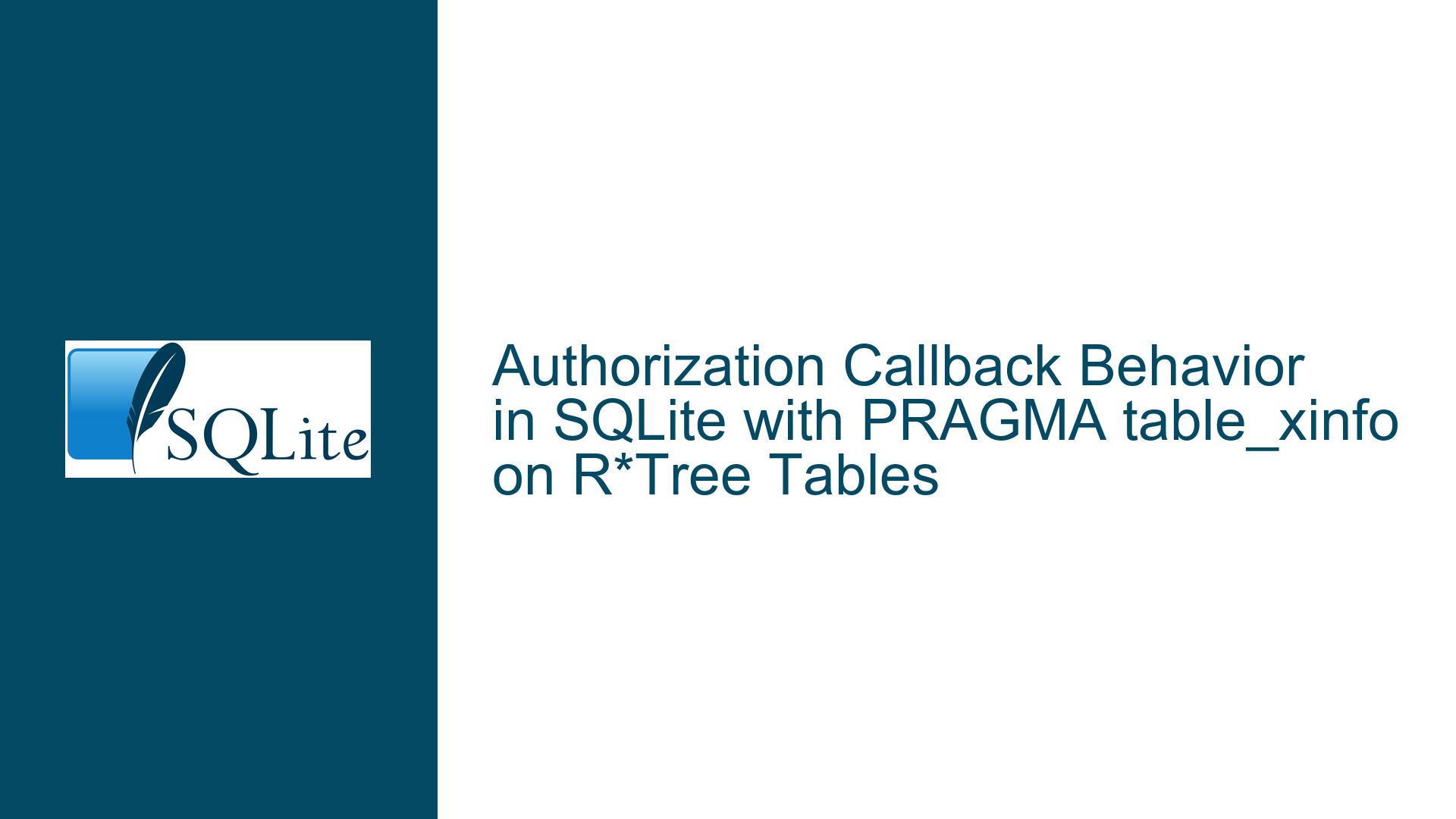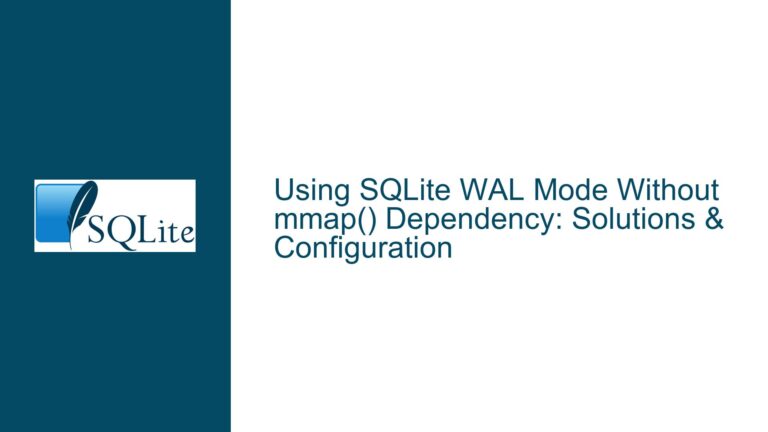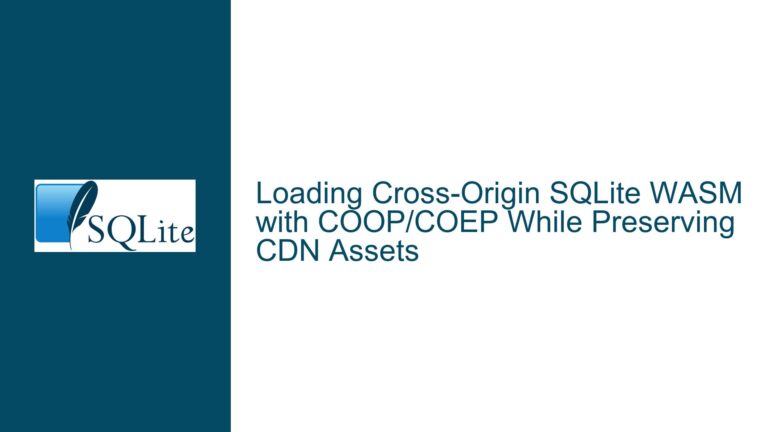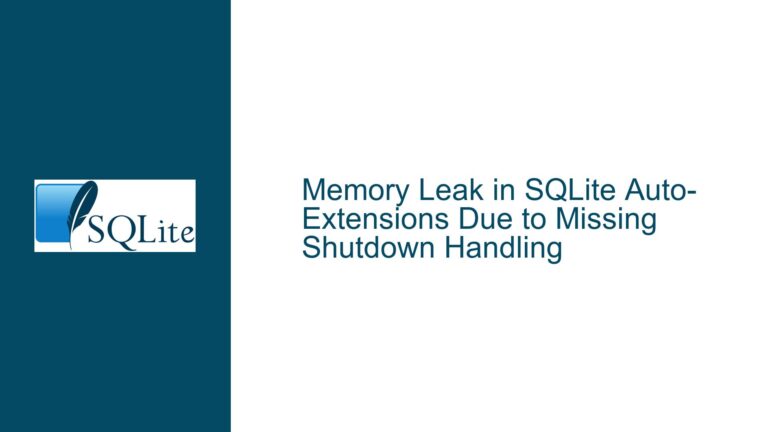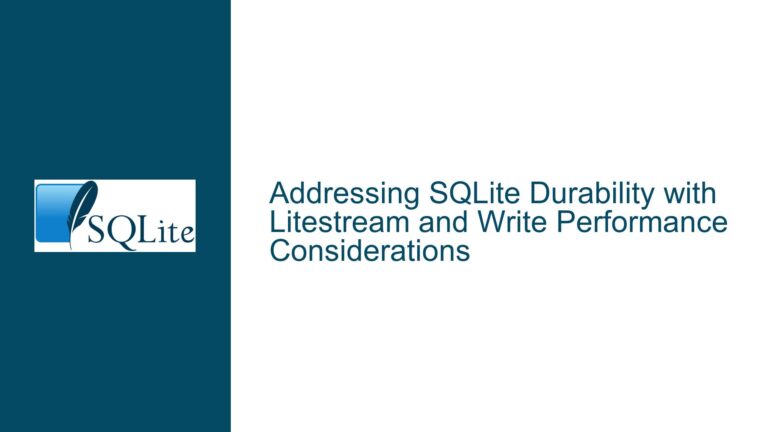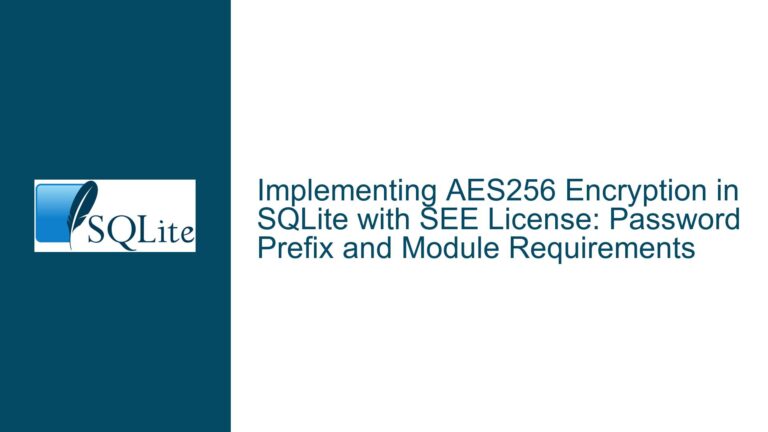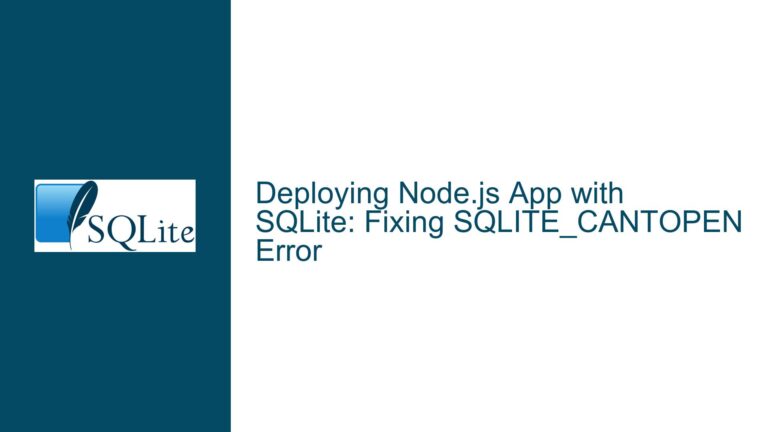Authorization Callback Behavior in SQLite with PRAGMA table_xinfo on R*Tree Tables
Understanding the Authorization Callback Behavior with PRAGMA table_xinfo on R*Tree Tables
The core issue revolves around the unexpected behavior of SQLite’s authorization callback mechanism when executing PRAGMA table_xinfo on an RTree virtual table. Specifically, the authorization callback triggers additional SQLITE_UPDATE and SQLITE_READ operations on the sqlite_master table and other internal RTree tables when an unrelated table is renamed. This behavior does not occur when no table renaming operation is performed. The discrepancy suggests that the internal state of the SQLite database or the way it handles metadata for virtual tables is influenced by seemingly unrelated schema changes.
To understand this issue, we must first delve into the mechanics of SQLite’s authorization callback system, the structure of R*Tree virtual tables, and how schema modifications like table renaming can indirectly affect the database’s internal operations. The authorization callback is designed to provide fine-grained control over database operations by allowing the application to monitor or restrict specific actions. However, the observed behavior indicates that certain internal operations, which are typically transparent to the user, become visible through the callback when schema changes are made.
The RTree virtual table, a specialized table type in SQLite for spatial indexing, introduces additional complexity due to its internal structure. Unlike regular tables, RTree tables are implemented using multiple shadow tables (e.g., t1_node, t1_rowid, t1_parent) to manage spatial data efficiently. When PRAGMA table_xinfo is executed on an R*Tree table, SQLite internally accesses these shadow tables to retrieve metadata. The renaming of an unrelated table appears to trigger a re-evaluation or re-initialization of the database’s internal state, causing the authorization callback to capture operations that would otherwise remain hidden.
Exploring the Causes of Authorization Callback Discrepancies
The root cause of this behavior lies in the interplay between SQLite’s schema modification mechanisms and its handling of virtual tables. When a table is renamed using the ALTER TABLE statement, SQLite performs a series of internal updates to the sqlite_master table, which stores the database schema. These updates include modifying the type, name, tbl_name, rootpage, and sql columns of the sqlite_master table to reflect the new table name. These operations are captured by the authorization callback as SQLITE_UPDATE events.
However, the unexpected aspect is that these updates to sqlite_master also affect the way SQLite processes metadata queries on RTree tables. The PRAGMA table_xinfo command, which retrieves information about the columns of a table, appears to trigger additional internal queries on the shadow tables associated with the RTree table. These queries include SQLITE_READ operations on tables like t1_node, t1_rowid, and t1_parent, as well as SQLITE_INSERT and SQLITE_DELETE operations that are part of the internal management of the R*Tree structure.
The renaming of an unrelated table seems to force SQLite to reinitialize or revalidate its internal state, causing these normally hidden operations to surface through the authorization callback. This behavior suggests that schema modifications can have side effects on the database’s internal consistency checks, particularly when virtual tables are involved. The R*Tree implementation, with its reliance on shadow tables and specialized indexing, is particularly susceptible to such side effects.
Another contributing factor is the timing and sequence of operations. In the provided code, the PRAGMA table_xinfo command is executed immediately after the table renaming operation. This sequence may cause SQLite to perform additional internal checks or optimizations that are not triggered when the database schema remains unchanged. The authorization callback, being a low-level mechanism, captures these internal operations, revealing the underlying complexity of SQLite’s virtual table implementation.
Resolving and Mitigating Authorization Callback Anomalies
To address this issue, it is essential to understand the context in which the authorization callback is being used and the specific requirements of the application. If the goal is to monitor or restrict access to certain database operations, the observed behavior may require adjustments to the authorization logic or the way schema modifications are handled.
One approach is to filter or ignore the additional SQLITE_UPDATE and SQLITE_READ operations that are triggered by schema modifications. This can be achieved by extending the authorization callback function to recognize and handle these specific cases. For example, the callback could be modified to return SQLITE_OK for operations on sqlite_master or R*Tree shadow tables, effectively treating them as benign internal operations.
Another strategy is to avoid performing schema modifications, such as table renaming, while the authorization callback is active. By isolating schema changes from the execution of metadata queries, it may be possible to prevent the callback from capturing unexpected operations. This approach requires careful planning of the database workflow to ensure that schema modifications and metadata queries are performed in separate phases.
For applications that rely heavily on virtual tables like R*Tree, it may be beneficial to implement custom logic for handling metadata queries. Instead of using PRAGMA table_xinfo, the application could directly query the sqlite_master table or use specialized functions to retrieve information about the table structure. This approach provides greater control over the metadata retrieval process and reduces the likelihood of encountering unexpected behavior.
In cases where the observed behavior is deemed undesirable or problematic, it may be necessary to consult the SQLite documentation or seek assistance from the SQLite development team. The behavior described in this issue may be a result of implementation details or optimizations that are not fully documented. By providing a detailed report of the issue, including the specific use case and the observed behavior, it may be possible to influence future improvements or clarifications in the SQLite codebase.
Finally, it is important to consider the broader implications of this issue for database design and application development. The interaction between schema modifications, virtual tables, and authorization callbacks highlights the complexity of SQLite’s internal mechanisms. Developers working with SQLite should be aware of these nuances and plan their database workflows accordingly. By understanding the underlying causes of such issues and adopting appropriate mitigation strategies, it is possible to build robust and reliable applications that leverage the full power of SQLite.
